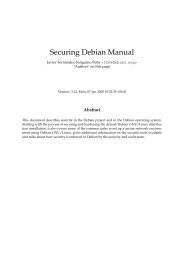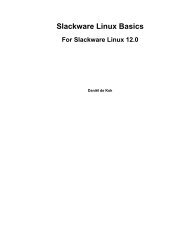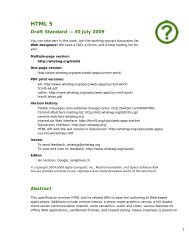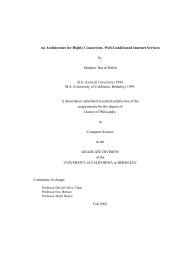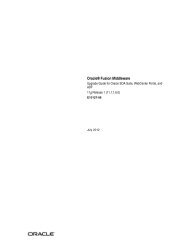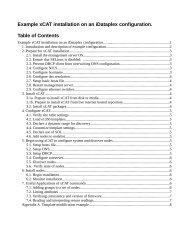PHP Leads Web 2.0 - Huihoo
PHP Leads Web 2.0 - Huihoo
PHP Leads Web 2.0 - Huihoo
You also want an ePaper? Increase the reach of your titles
YUMPU automatically turns print PDFs into web optimized ePapers that Google loves.
<strong>PHP</strong><br />
White Paper:<br />
<strong>PHP</strong> <strong>Leads</strong> <strong>Web</strong> <strong>2.0</strong><br />
A Closer Look at the Hidden Drivers and Enablers<br />
of the Second Internet Revolution<br />
By Andi Gutmans, Co-Founder and Vice President of Technology,<br />
Zend Technologies, Inc.<br />
September 2006<br />
© 2006 Zend Technologies, Inc. All rights reserved.<br />
Business
<strong>PHP</strong><br />
Everyone is currently talking about <strong>Web</strong> <strong>2.0</strong>, it is the next big thing in the IT industry. But most people have only a<br />
vague idea of what <strong>Web</strong> <strong>2.0</strong> is about — and what it is not. They tend to think of <strong>Web</strong> <strong>2.0</strong> as a collection of websites<br />
and fancy web-based applications. What they don’t see is the shift of paradigm that <strong>Web</strong> <strong>2.0</strong> brings — and the<br />
emergence of new technologies under the surface.<br />
Defining <strong>Web</strong> <strong>2.0</strong><br />
If you ask 20 people in the IT industry to define what <strong>Web</strong> <strong>2.0</strong> is, it is most likely that you will receive 20 different<br />
answers. This shows one of the main problems when talking about it: <strong>Web</strong> <strong>2.0</strong> is not a fixed standard or product,<br />
and the viewpoint of the individual influences his perception of <strong>Web</strong> <strong>2.0</strong>. For consumers or journalists outside the<br />
industry, <strong>Web</strong> <strong>2.0</strong> is a number of applications, websites and interfaces — Google, Flickr.com or even eBay. From a<br />
developer’s perspective, it is a collection of APIs, formats and code. And a CIO or CTO of a large company might<br />
see a new approach for software architecture that helps him to improve his application landscape.<br />
But it is hard to write an article about a new trend without giving a proper definition of it, isn’t it? Though my<br />
definition is definitely subjective, I tried to find some least common denominators. In my opinion, <strong>Web</strong> <strong>2.0</strong> usually<br />
includes one or more of these elements:<br />
• Rich <strong>Web</strong> Applications are most likely built with AJAX technology. Even though <strong>Web</strong> <strong>2.0</strong> is not<br />
only for public websites or applications, there is a large movement to build internal enterprise<br />
applications with web front ends to achieve platform independence and make it easier to deploy,<br />
manage and access business applications.<br />
• SOA (service oriented architecture). SOA means that a website or web application (or even a<br />
server-only application) exposes functionality via a service most commonly in our world, a web<br />
service. This makes the reusing services and the creation of new applications, the so called<br />
mash-ups, very easy.<br />
• Social <strong>Web</strong> elements. Almost all popular <strong>Web</strong> <strong>2.0</strong> applications offer collaborative or social<br />
functions that allow users to commit themselves and create new content. The user takes part in<br />
content creation, whether actively or passively.<br />
A Look Under the Hood — the Gears and Engines of <strong>Web</strong> <strong>2.0</strong><br />
At this stage, most people perceive <strong>Web</strong> <strong>2.0</strong> through the rapidly increasing number of dynamic websites like Flickr,<br />
Facebook, MySpace or Yahoo!. Compared to classic websites they are far more interactive and behave more and<br />
more like classic desktop applications, mostly thanks to AJAX, a client-side technology that resembles traditional<br />
user interface behavior in a browser. A good example is Zimbra 1 , a web based PIM application that offers the<br />
functionality of classic programs like Outlook or Thunderbird. It looks like a desktop application, it reacts almost<br />
as quick (or slow) as a desktop application — so is it a desktop application? Yes and no. Yes, because it performs all<br />
the tasks and actions you demand from it. No, because the underlying technologies and deployment methods are<br />
completely different.<br />
Let’s have a look at classic methods of developing, deploying and using applications. Usually, applications are<br />
written for a specific platform, be it Windows, Linux or the Mac, in a platform specific programming language like<br />
C++. The developer compiles the program and distributes it to the user. The user installs and runs the application.<br />
So far so good. If the user wants to use the application on more than one computer, he needs to install (and maybe<br />
licence) the application on all computers he wishes to use. Every time the application is updated, the user needs<br />
to install the update (on all computers). Now translate that into an enterprise with tens of thousands of employees<br />
and the ongoing maintenance of such applications becomes a real challenge.<br />
In the age of <strong>Web</strong> <strong>2.0</strong>, this process is very different: The developer writes the application in a platform<br />
independent manner. This means a) independent from the platform the application resides on (the server) and<br />
more important b) independent from the platform the application is used on (the PC of the user). For a) a<br />
combination of open source server platforms and programming languages has become very popular, called LAMP<br />
(Linux, Apache, MySQL, <strong>PHP</strong>/Perl/Python). For b) the best way to achieve platform independence is to write<br />
1 http://www.zimbra.com/<br />
w w w . z e n d . c o m<br />
Business<br />
2
<strong>PHP</strong><br />
applications that run on the server and represent their interface and results in a browser using standard HTML or<br />
XHTML plus AJAX. This kind of application needs no active distribution or installation — the user just uses it<br />
through his browser, and, if it is commercial software, subscribes to its service for a period of time. Plus: the user<br />
always works with the latest version of the software — no needs for updates or bug fixing. In addition, data<br />
migrations when upgrading applications have to be managed by the service provider and are therefore usually<br />
painless to the end user.<br />
This new application model of <strong>Web</strong> <strong>2.0</strong> has also changed the way the applications are developed: Instead of big,<br />
monolithic colossi of compiled applications with millions of lines of code, most <strong>Web</strong> <strong>2.0</strong> programs consist of a<br />
number of rather lean modules. Changes, extensions and updates of these programs are easier and faster, leading<br />
from a “one major release a year” scheme (Bugwriter 97, 98, 2000, XT, etc.) to a constant cycle of innovation<br />
with monthly or often even weekly new features.<br />
<strong>PHP</strong> – Programming Language of Choice for <strong>Web</strong> <strong>2.0</strong><br />
For programming <strong>Web</strong> <strong>2.0</strong> applications, <strong>PHP</strong> is certainly the number one language. About 20 million sites use <strong>PHP</strong> 2 ,<br />
among them some of the biggest names in the <strong>Web</strong> <strong>2.0</strong> sphere like Yahoo!, Flickr, Facebook, Friendster,<br />
Technorati, Zillow.com or Tagged.com. While there are other languages in the competition for web applications,<br />
like ASP, Perl, Python, Ruby to name a few, <strong>PHP</strong> leads the field here and has a market share of more than 30<br />
percent 3 .<br />
The renowned analyst Forrester Research evaluated 13 leading open source software projects across approximately<br />
40 criteria and found that six of the projects stand out as examples of excellence and are ready for corporate use 4 .<br />
<strong>PHP</strong> was the only dynamic programming language in this group and stood beside MySQL, Eclipse, Apache HTTP<br />
Server, Apache Tomcat, and the JBoss Application Server. As the US magazine eWeek attested, the LAMP-stack<br />
(and <strong>PHP</strong> in particular) delivers excellent performance compared to commercial alternatives such as Microsoft’s<br />
.Net: “This stack's performance numbers suggest what many who have been using <strong>PHP</strong> for some time now<br />
(including some of the busiest blogs on the <strong>Web</strong>) know to be true — that a pure LAMP-based <strong>PHP</strong> system can easily<br />
handle enterprise-class traffic and loads.” 5<br />
But what makes <strong>PHP</strong> so attractive for <strong>Web</strong> <strong>2.0</strong>? It’s the same features that make <strong>Web</strong> <strong>2.0</strong> itself so attractive: It’s<br />
easy to learn, easy to use, lightweight while offering full functionality and it can easily be extended. Modules and<br />
libraries make <strong>PHP</strong> work with a large number of APIs and other <strong>Web</strong> <strong>2.0</strong> technologies. For example, there are a<br />
large number of <strong>PHP</strong> toolkits that support creating AJAX-based <strong>Web</strong> applications.<br />
Another factor for the continuing success of <strong>PHP</strong> is the professional environment companies like Zend have created<br />
for the adoption of <strong>PHP</strong>: The Zend Core stack for example is specifically designed to create applications for IBM or<br />
Oracle databases 6 , and the open source Zend Framework will make <strong>PHP</strong> application development even easier. In<br />
addition, Zend is offering commercial development and management solutions for enterprise usage. This hybrid<br />
pattern of open source, cost free and commercial offerings is typical for <strong>Web</strong> <strong>2.0</strong> and supports rapid adoption and<br />
integration on the one hand and sustainable and manageable business models on the other hand.<br />
What <strong>Web</strong> <strong>2.0</strong> Means for the Enterprise<br />
When IT managers look at <strong>Web</strong> <strong>2.0</strong>, it often appears to them as consumer hype. Will this hype last? Will it have an<br />
impact on their business? Will it change the fundamentals of their traditional enterprise applications? Yes, yes and<br />
definitely.<br />
2 Source: <strong>PHP</strong>.net, http://www.php.net/usage.php<br />
3 Source: Nexen.net http://www.nexen.net/chiffres_cles/phpversion/php_statistics_for_june_2006.php#sglobal<br />
4<br />
Source: “The Forrester Wave Project Summary, Q2 2006”.<br />
http://www.forrester.com/Research/Document/Excerpt/0,7211,36338,00.html<br />
5<br />
Source: http://www.eweek.com/article2/0,1895,1983364,00.asp<br />
6 http://www.zend.com/products/zend_core<br />
w w w . z e n d . c o m<br />
Business<br />
3
<strong>PHP</strong><br />
But how? One explanation is the change in how technology penetration and acceptance work. In the past, most<br />
new IT technologies trickled down from the enterprise to home users — think of the PC, word processing or PDAs.<br />
This has changed in the past few years: Companies are faced with gadgets and technologies their employees bring<br />
to work: USB sticks, instant messaging or web based applications. Now people start using <strong>Web</strong> <strong>2.0</strong> tools within<br />
companies: They set up Wikis to document the progress on projects. They use internal and external blogs or<br />
podcasts to present ideas or to deliver training. They use eBay to sell unused office furniture. In short: Whenever<br />
an enterprise is facing a new gap in their existing applications, it is very likely that a <strong>Web</strong> <strong>2.0</strong> technology,<br />
application or service is used.<br />
Another factor that increases the importance of understanding <strong>Web</strong> <strong>2.0</strong> for business is the change in business<br />
applications themselves. Wikis, podcasts or blogs might be useful tools, but they are not considered mission<br />
critical applications. But CRM systems for example, are mission critical. One of the fastest growing CRM vendors,<br />
Salesforce.com, leverages heavily on basic <strong>Web</strong> <strong>2.0</strong> principles: The software is completely web based and licensed<br />
per user for periods of time. In addition, Salesforce.com has made APIs (application programming interfaces)<br />
public and enabled third party vendors (or the customer’s IT staff) to write extensions and enhancements to suit<br />
the program to individual needs. An example is an applet that shows a customer’s location on a map by interfacing<br />
with Google Maps. Not only does this eco-system of solution providers around Salesforce.com provide more value<br />
to its customers but it also enables its customers to leverage the open-standards based <strong>Web</strong> services to easily<br />
integrate into their business environment, e.g. integrating CRM data with their financial systems.<br />
What Salesforce.com and other companies do, is called ASP (application service providing) or software on demand.<br />
This principle has been around in IT for a while, but the breakthrough comes now, when the technologies are<br />
mature and bandwidth is no longer an issue. For customers, it offers not just lower prices, but eliminates the need<br />
for application administration. In addition, they need less time for training and they don’t have to worry about<br />
upgrading their employees PCs when the next version of the program comes out.<br />
But <strong>Web</strong> <strong>2.0</strong> means more to business than just using web based software. Two basic principles of <strong>Web</strong> <strong>2.0</strong> are the<br />
use of open standards and its ability to expose the functionality of other applications. That helps to exchange data<br />
between applications or to make one application call another program to service it, like using Google Maps from<br />
CRM software. In the future, this will lead to the use of smaller, more specialised applications. Whenever a<br />
company needs a certain function, it can buy or rent it as a service and integrate it in their web based applications.<br />
The Technology Drivers of <strong>Web</strong> <strong>2.0</strong><br />
In previous times, the major trends in the IT industry were led and set by a small number of big players — like IBM<br />
or Microsoft. With <strong>Web</strong> <strong>2.0</strong>, this has changed: Now the impetus comes from start-up companies, open source<br />
projects or corporate think tanks and is either standardized through various councils, initiatives and foundations or<br />
other times they just become de-facto standards without going through a heavy standardization process. In terms<br />
of technology development, this means that <strong>Web</strong> <strong>2.0</strong> was not there over night; instead it evolved (and continues to<br />
evolve) out of dozens of parallel technology and solution developments like XML, SOAP, <strong>PHP</strong>, MySQL, Linux,<br />
Apache, etc. Most of them were not built with the intention to create something like <strong>Web</strong> <strong>2.0</strong>, instead most of<br />
them were created to perform a certain task or to fulfill a certain need in the market: Linus Torvalds needed a<br />
UNIX alternative — thus Linux was born. The Linux community needed a web server — Apache was born. <strong>Web</strong><br />
developers needed an easy and performing scripting language that works with Apache – <strong>PHP</strong> was born which has<br />
grown into a full featured programming language within the last decade. That said, it’s important to note that<br />
LAMP is not the only incarnation of the <strong>Web</strong> <strong>2.0</strong> <strong>PHP</strong> stack. As previously mentioned <strong>PHP</strong> is cross-platform and has<br />
tight integration with other open-source and commercial operating systems, <strong>Web</strong> servers, and databases.<br />
Therefore many <strong>PHP</strong> users are mixing and matching various open-source and proprietary technologies, these<br />
incarnations include OLAP (Oracle, Linux, Apache, <strong>PHP</strong>), WAMP (Windows, Apache, MySQL, <strong>PHP</strong>) especially for<br />
development and other technologies, especially from the big vendors such as IBM, Oracle, Sun, and Microsoft.<br />
For businesses that want to stay up to date in terms of trends and technologies, this means that they have to listen<br />
to new sources: Emerging companies like MySQL (Databases), SugarCRM (<strong>PHP</strong>-based CRM) or Zend (<strong>PHP</strong><br />
programming) are the main technology stakeholders now. This isn’t an either/or choice between emerging and<br />
w w w . z e n d . c o m<br />
Business<br />
4
<strong>PHP</strong><br />
established vendors, but it’s important to note that a big bulk of the innovation is now being driven by the<br />
respective domain experts in these fields. Those are often emerging vendors, who excel in understanding how<br />
these technologies are changing the <strong>Web</strong> paradigm.<br />
This becomes increasingly important as <strong>Web</strong> <strong>2.0</strong> is being adopted by more and more companies for creating their<br />
own set of applications. The ability to mash up (combine) existing applications and services and exposing them in<br />
an easy to deploy and manage fashion makes an extremely strong value proposition. This is the reason why<br />
decision makers should keep an eye on these technologies and the various aspects of <strong>Web</strong> <strong>2.0</strong>, as they can have<br />
significant value to their businesses.<br />
Last, it is also critical for IT managers to recognize the immense value in the cultural and social aspects of these<br />
new applications. By enabling our users to not only be end users but also be participants in these applications, the<br />
ability to use their feedback as a knowledge multiplier inside the Enterprise is immense. Whether it’s sharing,<br />
tagging or ranking such information, the problem of solving the ultimate knowledge sharing problem in the<br />
Enterprise is finally being dealt with more efficiently.<br />
w w w . z e n d . c o m<br />
Business<br />
5
<strong>PHP</strong><br />
Contact Information<br />
United States and Canada:<br />
Zend Technologies, Inc.<br />
19200 Stevens Creek Blvd.<br />
Cupertino, CA 95014<br />
Tel: 1-888-<strong>PHP</strong>-ZEND (1-888-747-9363)<br />
Fax: 1-408-253-8801<br />
International:<br />
Zend Technologies, Ltd.<br />
7 Abba Hillel Street<br />
Silver Building<br />
Ramat Gan, Israel 52136<br />
Tel: 972-3-613-9665<br />
Fax: 972-3-613-9671<br />
Central Europe:<br />
Zend Technologies GmbH<br />
Bayerstraße 83<br />
80335 München, Deutschland<br />
Tel: +49-89-516199-0<br />
Fax: +49-89-516199-20<br />
w w w . z e n d . c o m<br />
Business<br />
6



